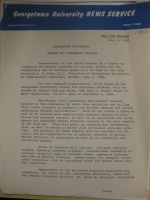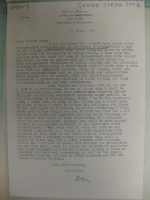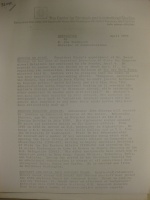Difference between revisions of "Center for Strategic and International Studies, timeline"
Richard Bew (talk | contribs) (→April) |
Richard Bew (talk | contribs) |
||
| Line 25: | Line 25: | ||
*Newsletter of April 1970, confirming David Abshire's appointment by President Nixon to 'Assistant Secretary of State for Congressional Relations'. The role was designed to use Abshire's expertise to focus on the growing role of Congress in the formation of foreign policy. | *Newsletter of April 1970, confirming David Abshire's appointment by President Nixon to 'Assistant Secretary of State for Congressional Relations'. The role was designed to use Abshire's expertise to focus on the growing role of Congress in the formation of foreign policy. | ||
*The newsletter also confirms the replacement of Abshire by Ambassador John Steeves as Executive Director of CSIS. | *The newsletter also confirms the replacement of Abshire by Ambassador John Steeves as Executive Director of CSIS. | ||
| + | |||
| + | ==1986== | ||
| + | [[Image:Georgetown_Archives_246.JPG||150px|thumb|right|Correspondence between Stanley Katz and Tim Healy, October 1986 ]] | ||
| + | ===October=== | ||
| + | *Letter from Tim Healy to Stanley Katz taking on board the recommendation of a separate incorporation of CSIS stating that 'we are proceeding to an orderly separation' and that he hopes 'to avoid any claims of rancour or displeasure.' | ||
Revision as of 14:50, 15 March 2016
This timeline records key events in the history of the CSIS, in particular from the period of its creation until it was removed from campus at Georgetown University in 1986.
1962
June
- The announcement of the establishment of The Centre for Strategic (and International) Studies was made by Reverend E.B Bunn, President of Georgetown University on June 4 1962. It's stated aim was 'to coordinate and conduct studies related to the strategies by which free societies can utilise their total strength to preserve and further develop the values underlying Western civilisation.'
- Donald Sheehan of the University of Pennsylvania writes to Reverend Bunn, expressing that he was 'impressed with the need for such an independent objective agency' and that 'a university provides an ideal setting for such an organisation as you have envisioned'.
1968
December
- Letter from Arleigh Burke to Father Campbell regarding the centre's name change from the Centre for Strategic Studies to the 'Centre for Strategic and International Studies' (CSIS). Father Campbell felt it important that the centre emphasise it's international focus alongside that of strategy.
1969
August
- Notification of CSIS constitutional changes to President Henle. Denotes name change to 'Centre for Strategic and International Studies', change of directorship to 'Chairman' to imply administrative role and central role of the Research Council in directing research,which replaced the Research Committee.
1970
April
- Newsletter of April 1970, confirming David Abshire's appointment by President Nixon to 'Assistant Secretary of State for Congressional Relations'. The role was designed to use Abshire's expertise to focus on the growing role of Congress in the formation of foreign policy.
- The newsletter also confirms the replacement of Abshire by Ambassador John Steeves as Executive Director of CSIS.
1986
October
- Letter from Tim Healy to Stanley Katz taking on board the recommendation of a separate incorporation of CSIS stating that 'we are proceeding to an orderly separation' and that he hopes 'to avoid any claims of rancour or displeasure.'





